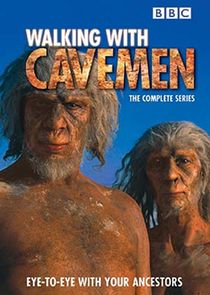Walking with CavemenŐsemberek között

Walking with Cavemen is a four-part television documentary series about human evolutionproduced by the BBC in the United Kingdom.
Like previous Walking with... documentaries, Walking with Cavemen is produced in the style of a nature documentary, featuring a voice-over narrator (Robert Winston in the British release, Alec Baldwin in the North American release) who describes the recreations of the prehistoric past as if they were real.
Befejezett / kaszált 2003.03 - 2003.04 | 60 perc @BBC One , GB
Galéria Robert Winston (Narrator), Alec Baldwin (Narrator)
Honlap | IMDb | SorozatJunkie | TV Maze | TMDB
03.27.
22:00

Epizód adatlap | SorozatJunkie | IMDb | Hozzászólások (0) |
In the first episode, we see Australopithecus afarensis, and focus on their evolved bipedality. The story follows the famous Lucy and her relatives, as they first develop a leadership conflict following the death of the alpha male due to a crocodile attack, and then are attacked by a rival troop. The attack ends with the death of Lucy herself, and her eldest daughter caring for Lucy's now-orphaned baby sibling, as a sign of the developing humanity in these "apemen".
Animals: Ancylotherium · Deinotherium · Verreaux's eagle · Crocodylus thorbjarnarsoni · Zebra finch
04.03.
22:00

Epizód adatlap | SorozatJunkie | IMDb | Hozzászólások (0) |
The second episode leaps forward to a time when Paranthropus boisei, Homo habilis and Homo rudolfensis co-exist. H. habilis is depicted as an intelligent omnivore that is more adaptable than the herbivorous P. boisei. The two species are contrasted, with H. habilis being "a jack of all trades", while P. boisei are "a master of one" - i.e. they are specialized herbivores while H. habilis are generalized omnivores. Consequently, though P. boisei are able to eat termites, tall grasses and hard acacia pods in difficult times, they will not be able to survive in the future, when at the beginning of the next Ice Age the climate will change, and these plants will be gone for good. H. habilis, on the contrary, have become smart by eating fresh carrion and bone marrow among other things, and evolving a basic social behavior, which is more firm than that of P. boisei, will continue to survive, until it evolves into Homo ergaster, seen in the next episode, who has developed these traits to a greater extent.
The episode also briefly shows the H. rudolfensis, remarking that although they are taller, they are very similar to the H. habilis.
Animals: Dinofelis · Deinotherium · Ancylotherium · Lion · Eland · Impala · Bees · Vultures
04.10.
22:00

Epizód adatlap | SorozatJunkie | IMDb | Hozzászólások (0) |
In the third episode, Homo ergaster is depicted as the first creature to master the art of tracking. This was made possible because their diet has grown increasingly more carnivorous, and the nutrients in meat made them even smarter than H. habilis of the previous episode. They also begin to form into tribal societies, with genuine bonds between their men and women, though violence is still occurring.
The episode later shows H. ergaster spreading into Asia, becoming Homo erectus and encountering the enormous herbivorous ape Gigantopithecus, "the original King Kong".
However, for the next million years, H. ergaster is still very much an animal, following its instinct, but then, they are shown harnessing fire and beginning to break-away from their direct dependence on their environment.
Animals: Wildebeest · African bush elephant · Swallow · Tarantula · Ants · Giraffe · Baboon · Gigantopithecus
04.23.
22:00

Epizód adatlap | SorozatJunkie | IMDb | Hozzászólások (0) |
The fourth episode first shows Homo heidelbergensis in Britain. H. heidelbergensis is depicted as intelligent and sensitive but lacking in the ability to comprehend an afterlife, or anything that isn't in the "here and now".
Next, the episode shows a clan of Homo neanderthalensis, how they lived and hunted, including the mighty mammoth during the last ice age. Finally in Africa then we see Homo sapiens idaltu which are not adapting well in Africa's drought unlike the Neanderthals in the north, along with them we see modern Homo sapiens (represented by bushmen), who had to become imaginative and inventive to survive the long drought unlike their subspecies idaltu, and finally glimpse the cave painters of Europe, who had "evolved" the idea of the afterlife and the supernatural, and now ready to start the human history as it is now known (and drive the Neanderthals to extinction).
Animals: Megaloceros · Mountain hare · Woolly mammoth · Beetle · Snake
